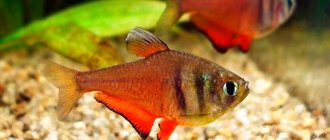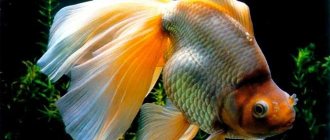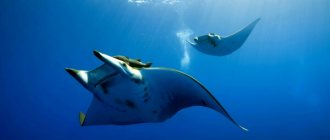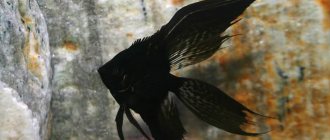5
(3)
Today there are many varieties of aquarium fish. Of course, already known species are more popular. For example, these are cockerels, swordtails, guppies, angelfish, golden ones, barbs, various catfish, etc. All of them are known to almost any person, even if he has nothing to do with aquariums. They can be found in every pet store. But sometimes a more experienced aquarist wants something unusual, more interesting.
Of course, it is not easy to find a fascinating representative of the underwater fauna, but they can still be found in Russia. For example, this includes the kalamoicht, which is also called the snake fish.
Description of the species
It’s worth noting right away that this pet is not for everyone. It is unlikely to appeal to adherents of traditional fish species, conservatives and aquarists suffering from ophidiophobia. But for people who are drawn to the exotic and love to amaze, the Kalamoikht will be an excellent purchase!
In common parlance, Calamoichthys calabaricus is better known as snake fish. Indeed, in appearance it is very similar to a reptile: a long flexible body covered with scales, a triangular, slightly flattened head and a large mouth with teeth.
For complete resemblance, the only thing missing is a forked tongue, but it is missing. Instead, there are small antennae that serve as an organ of touch for the kalamoicht.
The color can be anything from yellow-brown and green to reddish or ocher. There are 8-15 spines on the back just before the tail.
Compatibility
The aquarium snake fish, despite being a predator, gets along well with medium or large fish. Suitable for them:
- Synodontis fish;
- Cichlids (eg angelfish);
- Large thread-bearing gouramis;
- Severums;
- Large characins.
But the kalamoicht perceives smaller fish as prey, so it doesn’t get along well and will start hunting fish:
- Neons;
- Barbusov;
- Danio;
- Shrimp;
- Guppy;
- Mollies;
- Mechenostsev;
- Small tetras;
- Rasborov;
- Small catfish;
- Snails;
- Small amphibians.
The kalamoicht can also attack fish of its own size, fighting for food and territory. It is better to have only one male present. Despite this, we can say that the kalamoicht has good compatibility in aquariums.
The difference between a male and a female
There are no dorsal and ventral fins, but there is an anal fin, which is used to determine the sex of an individual. If the number of rays on it is 9-12, then it is a female. If there are 12-14 pieces, it’s a male. If there are exactly 12 rays (which often happens), then it depends on your luck.
But gender is not the main thing that an aquarist needs to know, because kalamoichtas do not reproduce in captivity. There have been cases when animals gave birth to offspring in aquarium conditions, but this is rather an exception to the rule.
Calamoichts are bred on special farms or caught in their natural habitat.
What to feed snake fish?
In nature, kalamoichtas feed on worms, crustaceans and insects at night. Due to poor eyesight, they rely on an excellent sense of smell. In captivity, individuals rarely accept granulated and other dry foods. Frozen and live meat foods are ideal, in particular shrimp, earthworms, shellfish, bloodworms and others.
Feeding
Due to very poor eyesight, the kalamoichta developed an excellent sense of smell. It prefers live foods such as bloodworms, small worms, and earthworms.
You can also give pieces of shrimp, fish fillets, and squid. Predatory, will hunt small fish and snails.
The biggest difficulty in feeding the kalamoicht is its slowness. While he is thinking, the rest of the fish are already finishing their food. Due to poor eyesight and the habit of hiding, kalamoichts are the last to find food.
To prevent them from starving, drop the food directly in front of them, or feed them at night, when they are most active.
This will give them the opportunity to eat normally, since they lose the usual race with fish.
Before you buy
You need to know that animals have a hard time getting used to artificial living conditions. Before sale, they must undergo an adaptation period of at least two weeks.
Often, due to the thirst for profit, sellers neglect this criterion and put them up for sale immediately after catching them.
Therefore, before buying fish in a pet store, the future owner should find out whether the snake has passed quarantine, so that a pleasant purchase does not turn into disappointment and the imminent death of the pet.
You should not take a fish if uneven coloration is visible on the surface of its body, there are contrasting spots or mucus. Most likely, such an individual is sick and will not live long in the aquarium.
Habitat in nature
Kalamoicht calabar lives in western Africa, in the waters of Nigeria and Congo, Angola, Cameroon.
In nature, it lives in stagnant or slow-flowing water, with a low oxygen content, to which the kalamoicht has adapted and can literally stick its head out of the water to breathe atmospheric oxygen.
The fish has developed lungs, which allow it to even live on land for some time, subject to high air humidity.
The snake fish is an ancient creature that can even be called a fossil. In nature they can grow up to 90 cm in length, in an aquarium they are usually much smaller - about 30-40 cm in length.
Life expectancy is up to 8 years.
Maintenance and care
Kalamoikhtas breathe atmospheric air, so you should not worry too much about aeration of the aquarium if only this type of fish lives in it. An air plug left above the surface of the water will be enough to satisfy their need for oxygen.
The lid of the aquarium should be tight and without holes, as due to its curious nature the fish can easily get out.
Kalamoichts are fish accustomed to life in natural bodies of water. This is worth considering when choosing an aquarium, soil, plants and shelters for your future pet.
A snake accustomed to the wide river expanses of West Africa will be comfortable in an aquarium with a volume of 100 liters or more .
Due to living in turbid river water, the Calabar calamoichta's vision is poorly developed, so the main senses are touch and smell.
It is advisable to use sand or fine gravel as the soil
It is recommended to bury the roots of plants deeper into the gravel and press them down with stones to protect them from damage when the fish swarms in the ground.
The gravel layer should be 3-5 cm. Kalamoihts will gratefully accept a variety of shelters and burrows that the owner will create for his pets from stones, driftwood or artificial castles from pet stores. There they feel safe and comfortable.
The water temperature should be within 22-28°C, pH 6.5-7.5, gH 2-15. It is very important to keep all indicators stable, since the fish are very sensitive to changes in the hydrochemical composition of the water.
Do not neglect filtration and weekly replacement of 1/5 of the water. During the adaptation period or during an emergency shift, Biotopol, Stresscoat or JblAcclimol conditioners can be used.
During treatment, fish do not tolerate formaldehyde, excessive salting of water and organic dyes.
Snake fish habitat
The habitat of the species Erpetoichthys calabaricus stretches from the mouth of the Ogun River in Nigeria to the Shiluango River in the Congo, the city of Brazzaville, Republic of the Congo. Individuals inhabit fresh or brackish slow-flowing rivers or bodies of standing water. Apparently, the kalamoichta biotope is overgrown with reeds.
The fish move along the bottom, making snake-like movements, as well as moving sideways. Being an amphibious fish, the kalamoicht has paired pulmonary sacs (formations from the swim bladder), the lumen of which is located in the esophagus. One research study determined the involvement of gills, lung sacs and skin in the respiration of snake fish.
The studied individuals were placed in a special chamber. It has been shown that in terms of oxygen consumption, the lung sacs account for 40%, the gills account for 28%, and the skin accounts for 32%. Thus, the kalamoicht is able to breathe atmospheric air and stay on land for a short time [Sacca, Burggren, 1982].
History of Kalamoicht
This amazing snake fish was first presented in 1906, in Europe, at an exhibition of aquarium animals held in Magdeburg. The “Aquarium” of the Stockholm ethnographic park “Skansen” donated 4 copies of the Calabar Kalamoichta to the “Aquarium” of the Moscow Zoo in 1984. And only 20 years after this, Kalamaicht confidently took the position of a common aquarium resident.
Established over 40 million years ago. years ago, the Calabar Kalamaicht today is almost no different in appearance from its ancestors Cladistia, which are considered one of the most ancient fish on our planet. The past centuries of evolution have left the modern specimen with only pectoral fins, almost completely excluding the pelvic fins, or moving them as far as possible to the tail, crowned with small dorsal spines.
Many scientists are interested in this type of fish because, according to numerous theories, it is from such creatures that the modern inhabitants of our planet originated. Being a completely aquatic inhabitant, Kalamoicht has lungs, which are two equal lung sacs, similar in structure to the lungs of many mammals and not at all similar in structure to the respiratory system of many fish.
There are versions, theories that in the process of evolution, some of the fellow kalamoichtas grew limbs and came to land.
VIDEO
Reproduction of Calabar calamoichts
Interest in kalamoichts as aquarium objects is growing year by year. Despite their growing popularity, only a few have been able to breed them in captivity.
Puberty in kalamoichts occurs by the age of 3. Breeding them in an aquarium without the use of hormonal drugs is very difficult, but possible. Several such cases have been officially recorded.
Individuals of the opposite sex get along well with each other and often lie on the bottom entwined with each other.
When the spawners are ready to spawn, they slowly circle around the thickets of small-leaved plants, keeping almost parallel to each other. Periodically, gracefully wriggling, they swim through the plants. At a certain moment, the male comes close to the female, almost touching her, and begins to push her with his head. In response, the female stops in the thickets of plants, thereby letting the male know that she is ready. The male moves towards the female's head until their anal fins are level, after which he hugs her with his fin. In this situation, producers freeze for a short time. During which the female lays a portion of eggs in a cup formed by the anal fin of the male, where fertilization occurs. Then the male, with rapid movements of the caudal fin, scatters the fertilized eggs inside the thicket of vegetation.
A pair of Calabar calamoichts in an aquarium
Sticky, spherical eggs with a diameter of 2.1-2.6 mm are glued to the plant substrate. After which the process is repeated until all the eggs have been deposited.
Kalamoichta larvae hatch on the third day and remain hanging on the substrate. They have a dark, almost black color, and their body length is short enough to be seen as future snake fish. Like the larvae of some amphibians, they have a pair of branched external gills. After three days, their body noticeably lengthens. On the thirteenth day, the yolk sac significantly decreases in size and eyes begin to form. On the nineteenth day, the yolk sac completely disappears and the ten-millimeter larvae begin to swim and feed on artemia nauplii. The singing rays of the caudal fin begin to differ after the fry reach 13 mm in length. The rays of the dorsal fin appear later, when the fry is 20 mm long. The coloring of eel fry still remains dark. The first diamond-shaped scales appear in the tail area. This occurs when the fry are 30 mm in size, and at the same time, nasal tubes are formed. They become clearly visible when the length of the juveniles is close to 40 mm. By five months of age, calamoikht reach a size of 60 mm.
Today, calomichts can often be found on sale. Having chosen these interesting fish, you should take a close look at their appearance and behavior before purchasing. When importing aquatic animals, oxygen is usually pumped into shipping bags. Importers do not always take into account the fact that calamoichtas capture atmospheric air during breathing, and oxygen can burn the mucous membranes of the swim bladder and intestines, which can subsequently lead to the death of the fish.
Snake fish behavior
https://www.youtube.com/watch?v=sD1xSsG0n6E
When choosing a company for such original pets, you should immediately exclude small-sized inhabitants - they will consider individuals that fit into the mouth of snake fish only as food. You can house snakes:
- carp;
- characins;
- cichlids;
- soms;
- angelfish;
- tilapia;
- severums;
- synodontis.
But you can limit yourself to the inhabitants of only one species; calamoikhtas are not aggressive and non-territorial, they coexist perfectly with their fellows.
The Calabarian is active both at night and during the day. The snake-like fish can calmly stay near the walls of the aquarium, watching what is happening through the glass. While searching for food, she shows particular ingenuity - she gradually narrows her circles until she stumbles upon food, or digs it out from under pebbles and sand.
Kalamoicht calabar is an exotic and incredibly interesting aquarium fish, characterized by its unpretentiousness and calm character, thanks to which even a novice aquarist who wants to acquire an unusual pet can cope with its maintenance.
Freshwater moray (Gymnothorax tile)
The freshwater moray eel is a very unusual pet for the home aquarium. In nature, it lives in brackish river estuaries in India and Indonesia. This fish has a long, rounded body with a narrowed muzzle, skin without scales, and covered with protective mucus. The color of the fish is brownish or grayish. Moray eels grow up to 60 cm. These are typical ambush predators. Adults should be kept alone due to their territoriality. Moray eels live well in completely fresh water, but adding salt to 5 ppm improves the quality of life of these fish. Among their neighbors, moving, not small fish, such as argus, monodactyls, will join them in company - they also react positively to low salinity of water. The required volume of an aquarium for moray eels is from 200-300 liters. The lid must always be closed!
basic information
Snakefish are not often found in private aquariums. Only a small number of enthusiasts are engaged in their breeding. However, individuals are often found in pet stores. If you want to purchase such a pet or its close relative, the Nile polyfeather, there will be absolutely no difficulties.
It is noteworthy that the deeper the knowledge of an aquarium hobbyist in zoology, the higher his interest in kalamoichts. Snake fish belong to the class of ray-finned fish, a subclass of cartilaginous fish from the polyfinned family.











